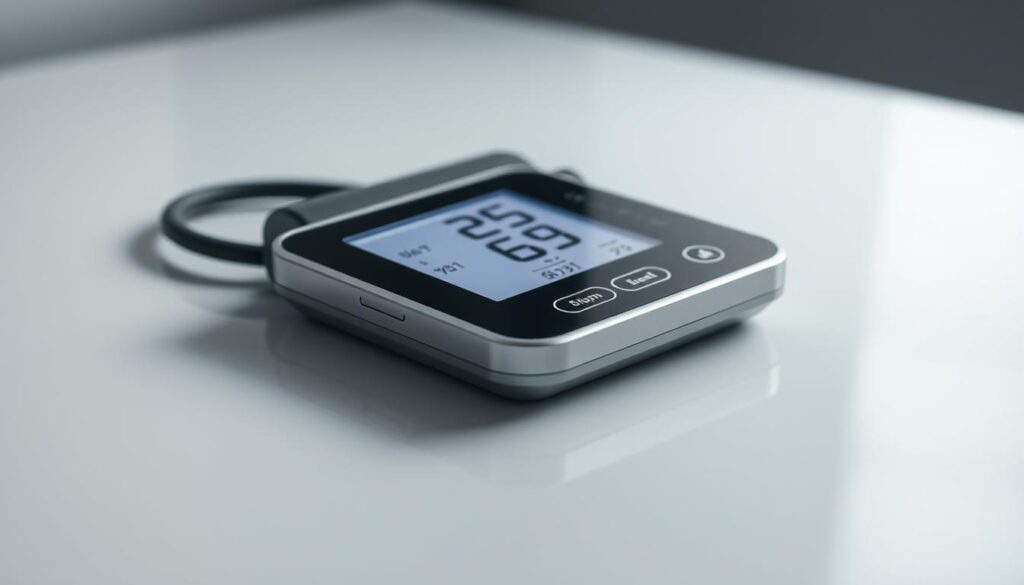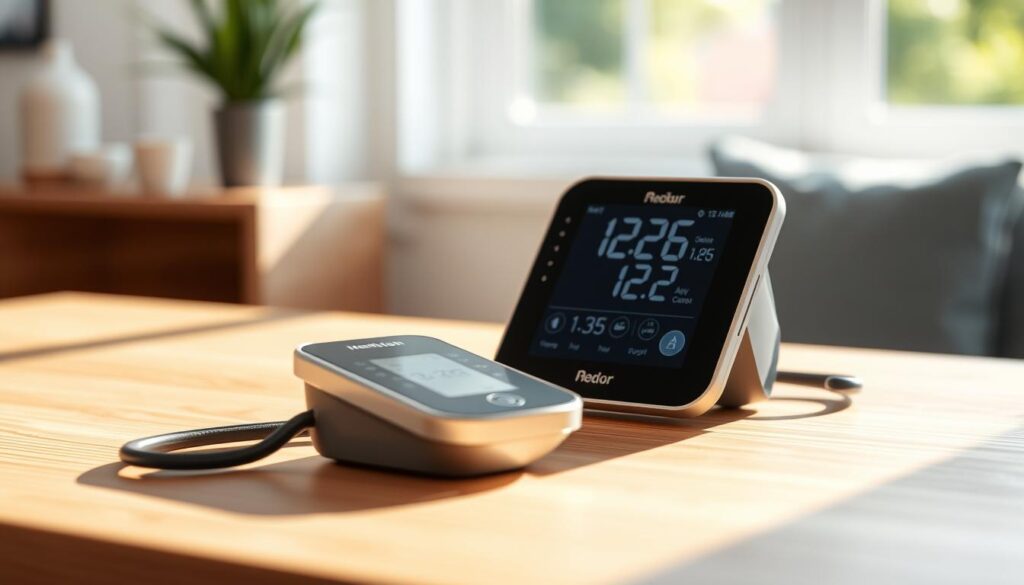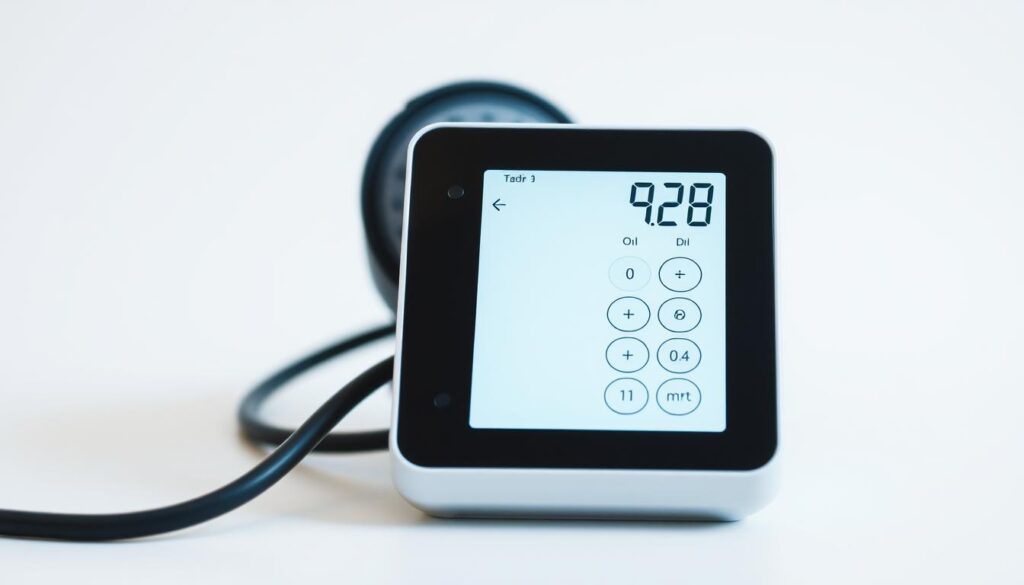Blood Pressure Check
Enter your numbers to get instant analysis
Your Result
Healthy Heart Tips
- ✅ Eat more fruits and vegetables
- ✅ Walk at least 30 minutes daily
- ✅ Reduce salt in your diet
- ✅ Maintain a healthy weight
- ✅ Manage stress through relaxation
Morning is ideal, before medications or coffee. Take readings at the same time daily for consistent tracking.
Use your left arm (closer to heart). If readings differ between arms, use the one with higher numbers.
How to Use Our Blood Pressure Calculator for Better Health
Keeping an eye on your blood pressure is key for good health. High or low blood pressure can cause big health problems. That’s why it’s important to check it often. A blood pressure calculator is a great tool to help you understand your numbers and see your health risks.

With a blood pressure calculator, you can see if your blood pressure is okay. Knowing this lets you take steps to keep your health in check. You might make lifestyle changes or talk to your doctor.
Key Takeaways
- Understand the importance of monitoring your blood pressure.
- Learn how a blood pressure calculator can help assess your health risks.
- Discover the benefits of maintaining healthy blood pressure levels.
- Find out how to take proactive steps towards managing your health.
- Understand the role of lifestyle changes in managing blood pressure.
Understanding Blood Pressure and Why It Matters
Blood pressure is key to our health. Knowing about it helps us stay well. It shows if we might get heart disease or stroke.
What Blood Pressure Numbers Mean
Blood pressure has two numbers: systolic and diastolic. The top number shows pressure when the heart beats. The bottom number shows pressure between beats. A good reading is about 120/80 mmHg.

Health Risks Associated with Abnormal Blood Pressure
High or low blood pressure is bad. High blood pressure harms arteries, heart, and kidneys. Low blood pressure can cause dizziness and not enough blood to organs.
The Importance of Regular Monitoring
Checking blood pressure often is important. A blood pressure monitor at home is helpful. It lets doctors know if there are problems.
Knowing and controlling blood pressure lowers heart disease risk. It makes life better.
What Is a Blood Pressure Calculator?
Blood pressure calculators are modern tools for tracking blood pressure. They give accurate insights into your heart health.
Features and Functions of Digital Blood Pressure Tools
Digital blood pressure calculators have many features. They make tracking blood pressure easier. Some key features include:
- Automated readings for accuracy
- Data storage for tracking progress over time
- Alerts for abnormal readings
- Integration with other health metrics for a comprehensive view of your health

Differences Between Calculators and Traditional Monitors
Digital blood pressure calculators do more than just measure blood pressure. They analyze data and offer insights and advice. This makes them a better tool for managing high blood pressure.
How Our Calculator Stands Out
Our blood pressure calculator is easy to use. It gives personalized insights based on your health data. It’s a key tool for managing blood pressure. The benefits include:
- Accurate tracking of your blood pressure over time
- Customized advice for lifestyle adjustments
- Seamless integration with your healthcare routine
Learning to use a blood pressure calculator helps you manage your heart health better.
How to Use and Benefit and More Information Blood Pressure Calculator
Accurate blood pressure monitoring starts with knowing how to use our Blood Pressure Calculator. Just a few simple steps will help you get accurate blood pressure readings every time.
Setting Up Your Profile
The first step is setting up your profile. You’ll enter some basic information. This makes the calculator’s output fit your needs better. You’ll get insights into your blood pressure trends.
Entering Your Blood Pressure Readings
After setting up your profile, start entering your blood pressure readings. It’s important to enter these readings correctly. This ensures the calculator gives you reliable data. Our tool makes monitoring blood pressure at home easier and more reliable.
Navigating the Dashboard and Reports
After entering your readings, go to the dashboard and reports section. Here, you’ll see a clear overview of your blood pressure trends. The dashboard is easy to use, so you can understand your data quickly.
Viewing Historical Data
Our Blood Pressure Calculator lets you view historical data. This helps you track changes in your blood pressure over time. It gives you valuable insights into your health.
Understanding Trend Analysis
Our calculator also does trend analysis. It helps you see patterns in your blood pressure readings. By analyzing these trends, you can make better health decisions and manage your blood pressure better.
By following these steps and using our Blood Pressure Calculator, you can manage your blood pressure health. Regular monitoring and accurate readings are crucial. They help you understand your condition and make lifestyle changes.
Interpreting Your Blood Pressure Results
Knowing how to read your blood pressure results is key to managing your health. It’s important to understand your readings to spot health risks early. This knowledge helps you make smart choices for your well-being.
Normal vs. Elevated Blood Pressure Categories
Blood pressure levels range from normal to very high. Knowing these categories helps you see where your readings fall.
- Normal: Less than 120/80 mmHg
- Elevated: Systolic between 120-129 and diastolic less than 80 mmHg
- Hypertension Stage 1: Systolic between 130-139 or diastolic between 80-89 mmHg
- Hypertension Stage 2: Systolic 140 or higher or diastolic 90 or higher mmHg
Understanding Systolic and Diastolic Variations
Systolic and diastolic readings tell you about your heart’s health. Systolic pressure shows the heart’s force when it beats. Diastolic pressure shows the force between beats.
When to Consult a Healthcare Professional
If your blood pressure is often high or you feel dizzy or have chest pain, see a doctor. It’s crucial for your health.
Making Sense of Long-Term Trends
Watching your blood pressure over time is important. It helps you see patterns and trends. This info is key to managing your health.
| Category | Systolic (mmHg) | Diastolic (mmHg) |
| Normal | < 120 | < 80 |
| Elevated | 120-129 | < 80 |
| Hypertension Stage 1 | 130-139 | 80-89 |
Tips for Getting Accurate Blood Pressure Readings at Home
Getting accurate blood pressure readings at home needs focus. Self-monitoring blood pressure helps manage health. But, it’s key to use the right methods for accurate results.
Proper Body Position and Cuff Placement
Sit comfortably with your back straight and feet on the floor. The cuff should be on your bare arm, at heart level. It should not be too tight or too loose. Proper cuff placement is crucial for accurate readings.
Optimal Timing for Measurements
Consistency is important for timing blood pressure measurements. Take readings at the same time each day, like morning and evening. Don’t take readings right after waking or before bed.
Avoiding Common Factors That Affect Readings
Many things can change blood pressure readings. Knowing these can help you avoid mistakes.
Effects of Caffeine and Exercise
Caffeine and exercise can raise blood pressure. Avoid caffeine and hard exercise for 30 minutes before taking a reading.
Impact of Stress and Anxiety
Stress and anxiety can also change readings. Take a few deep breaths and relax before measuring to reduce this effect.
By following these tips, you can get accurate blood pressure readings. This lets you maximize the benefits of self-monitoring blood pressure and make better health choices.
Integrating Blood Pressure Monitoring into Your Health Routine
Adding blood pressure checks to your daily routine can boost your health. It lets you track changes and make smart health choices.
Creating a Consistent Monitoring Schedule
For accurate readings, set a regular time for checks. Try the same time each day, like morning or night. This keeps your readings consistent.
Sharing Results with Healthcare Providers
Telling your doctor about your blood pressure is key. It helps them understand your health better. Many devices and apps let you share your data easily.
Using Insights to Make Lifestyle Adjustments
Your blood pressure data can guide lifestyle changes. If high readings follow certain foods, change your diet. This can help lower your blood pressure.
Combining with Other Health Metrics
Linking blood pressure with other health signs gives a full health picture. This includes heart rate, sleep, and activity. It shows trends that might not be seen alone.
By adding blood pressure checks to your routine, you can improve your health. Use the insights to make positive changes.
Conclusion
Using a blood pressure calculator is easy and helpful. It lets you keep an eye on your blood pressure. This way, you can spot health risks early and make smart choices about your life.
It’s not just about watching your numbers. It also helps you take charge of your health. By checking your blood pressure often, you can work with your doctor. Together, you can change your treatment plan and get healthier.
Adding a blood pressure calculator to your daily routine is smart. It gives you important info about your heart health. Start using one today and see how it helps you stay healthy for the future.